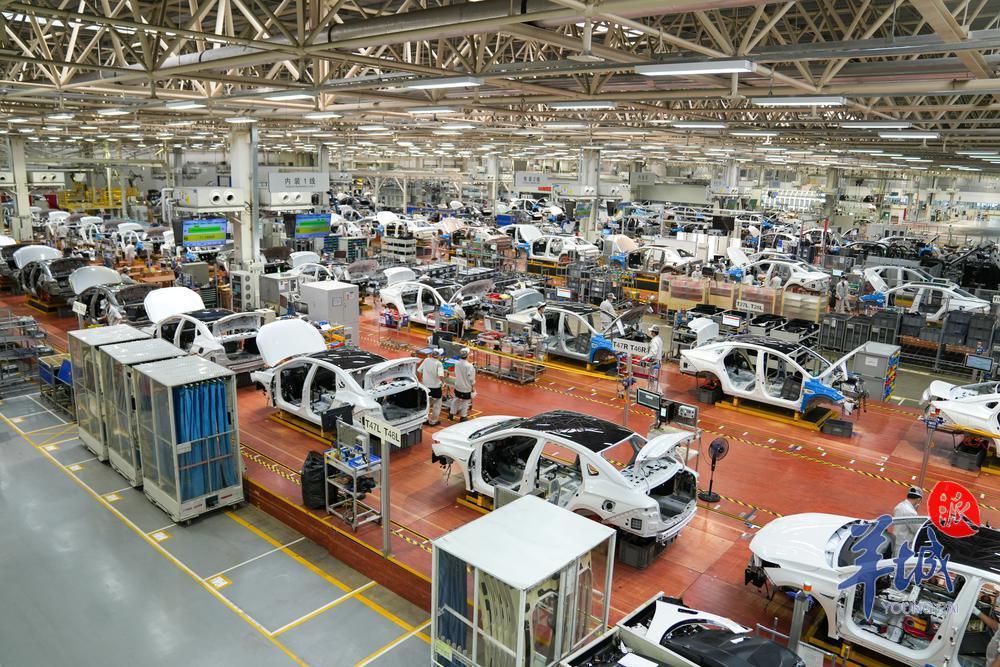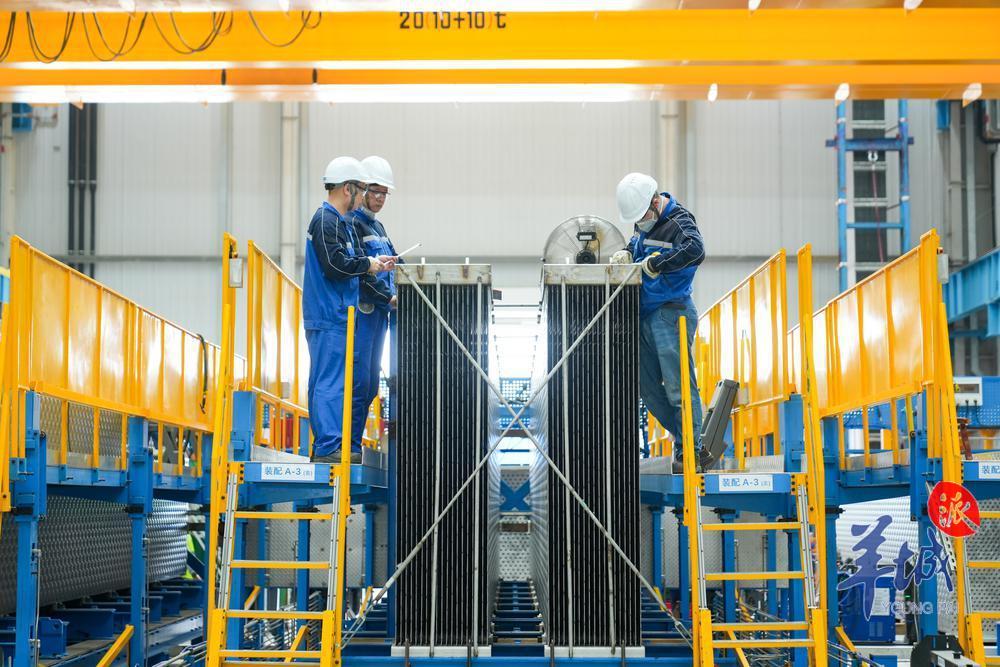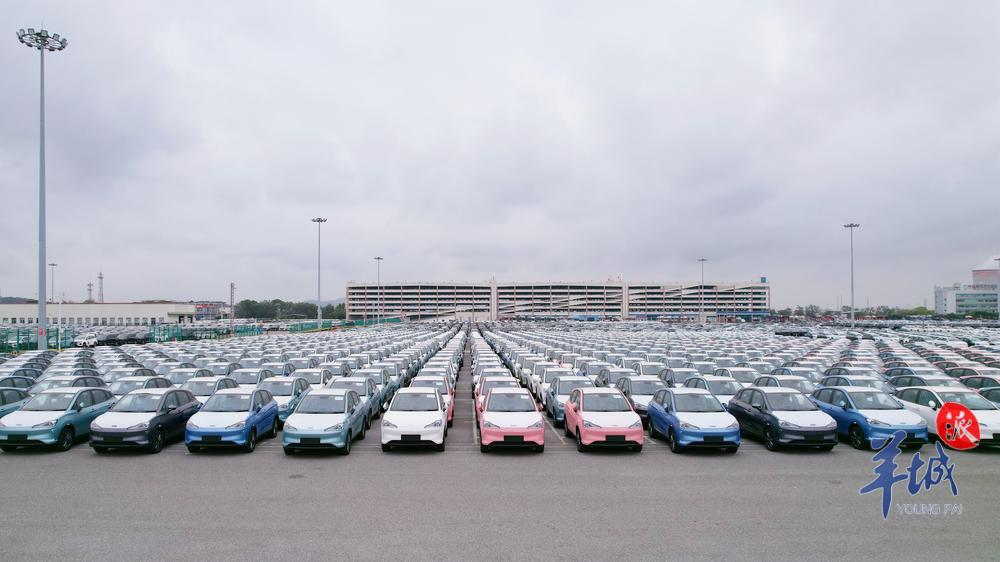
Industry plays a vital role in economic development. At the beginning of the 2024 Chinese New Year, Guangdong has not only implemented a series of strategic emerging industry projects but has also been planning to create an industrial technology innovation center with global influence. In Guangdong, a relay race towards high-quality development, accelerated cultivation of new productive forces, and accumulation of new momentum for future development has been initiated.

Tackling major challenges in enterprise innovation
The key to developing new productive forces lies in technological innovation. What is the current status of Guangdong's technological innovation? The independently cultivated "Zhongxing No.1," a new prawn variety, has broken the monopoly of foreign sources, while Asia's first deepwater jacketplatform"Haiji One" has been put into operation. Furthermore, the production milestone of 6 million new energy vehicles was achieved by BYD.Meanwhile, China's first purely commercial photomask production line, Guangdong's first silicon carbide production line, and two 12-inch wafer manufacturing lines have been put into operation. These examples epitomize the strength of technological innovation in Guangdong.
What are Guangdong's strongest abilities in innovation? For a long period of time, the strong innovation capability of enterprises has always been a prominent advantage of Guangdong's industries. According to data from the Department of Science and Technology of Guangdong Province, approximately 90% of research institutions, researchers, R&D funds, and patent applications in Guangdong come from enterprises. Furthermore, it is estimated that there will be over 75,000 high-tech companies and more than 76,000 science and technology-based small and medium-sized enterprises in the province.
The path to innovation also lies in attracting talents. Implementing incentive policies catering to talents introduced in cooperation platforms like Hengqin, Qianhai, Nansha, and Hetao, as well as Shenzhen being selected as a pilot city for national sci-tech talent evaluation reform, are both measures taken by Guangdong to attract talents. As of now, 277 provincial-level new R&D institutions have gathered 23,000 full-time researchers, providing services to approximately 120,000 enterprises.

Enhancing industry competitiveness through manufacturing upgrading
Industry is the main field for applying innovation, where the "world's factory," Guangdong, is demonstrating strong vitality. By 2023, the added value of industriesabove the designated size in Guangdong is expected to reach 4.13 trillion RMB, with a year-on-year growth of 4.4%, while the added value of 20 strategic industry clusters accounts for 40% of GDP. Among them, the added values of new energy vehicles, integrated circuits and optoelectronic devices have grown by 83.3%, 23.8%, and 17.9% respectively. With the rise of numerous new and traditional industries, Guangdong's confidence in industry advancement is solidified.
Emerging industries such as intelligent manufacturing and digital services are driving the cross-domain integration of traditional industries. In the Zhongshan production base of Hongrita, a Hong Kong-funded enterprise, the production process of the digital and intelligent workshop for health products, from feeding, part processing, to transportation, can be achieved without human operation, all in a fully automated manner, even with the lights turned off.
The "green revolution" sparked by technological innovation has continuously increased the environmental friendliness of the "Made in Guangdong" products. For example, the western area of the Midea Industrial Park in Foshan has transformed itself into a carbon-free park through process optimizing, equipment upgrading, and the use of green energy.
A set of data reveals the industrial changes brought by technological innovation across the province: in terms of digital transformation, around 5,000 enterprises above designated scale in Guangdong have successfully achieved digital transformation in 2023 through industrial cluster digital transformation projects; in terms of green transformation, comprehensive green manufacturing has been implemented, with the creation of 400 national-level green factories, 11 green industrial parks, and 80 green supply chain management enterprises.
Source: Yangcheng Evening News
广东高质量发展产业科技底气何在?
产业是经济发展的关键。新春伊始,广东不但加速落地一系列战略性新兴产业项目,更着力谋划打造具有全球影响力的产业科技创新中心。在南粤大地上,一场奔赴高质量发展高地、加快培育新质生产力、积蓄未来发展新势能的接力赛正按下快进键。
科技攻关,育强企业“创新力”
发展新质生产力,科技创新是核心驱动力。广东科技创新底气如何?自主培育的对虾“中兴一号”水产新品种打破国外种源垄断,亚洲领先的深水导管架“海基一号”正式投产,比亚迪下线第600万辆新能源汽车,国内首条高端纯商业化光掩膜产线、省内第一条碳化硅产线、两条12英寸芯片制造产业等投产,这些是广东科技创新实力的缩影。
广东区域创新能力强在哪?一直以来,企业创新能力强是广东产业的突出优势。广东省科技厅数据显示,广东约90%的科研机构、90%的科研人员、90%的研发经费、90%的发明专利申请都来源于企业。全省高新技术企业数量预计超7.5万家,全省科技型中小企业数量超7.6万家。
创新之道,又在广纳人才。推出横琴、前海、南沙、河套等合作平台系列人才创新政策包,深圳入选全国科技人才评价改革试点城市……这些都是广东吸引人才的举措。截至目前,全省277家省级新型研发机构集聚专职科研人员2.3万人,累计服务企业约12万家。

制造升级,锻强产业“竞争力”
工业是创新应用的主战场,“世界工厂”广东迸发出强劲生命力。2023年,广东规模以上工业增加值4.13万亿元,同比增长4.4%,20个战略性产业集群增加值占GDP比重达四成。其中,新能源汽车增长83.3%,集成电路增长23.8%,光电子器件增长17.9%。一批批新老产业乘势而起,夯实广东产业跃升的底气。
智能制造、数字服务等新兴产业,催生着传统产业的跨界融合。走进港资企业鸿利达的中山生产基地,健康品数字化智能化车间从上料、零件加工到运送的整个生产过程均可实现无人操作,在关灯状态下全自动化生产。
科技创新刮起的“绿旋风”,让“广东造”含绿量不断提升。例如,佛山美的工业园西区通过优化工艺、升级设备、使用绿色能源等,蜕变成为零碳园区。
一组数据可以揭示全省科技创新带来的产业变化:在数字化转型方面,广东通过实施产业集群数字化转型工程,2023年推动约5000家规模以上企业数字化转型;在绿色化改造方面,全面推行绿色制造,累计创建国家级绿色工厂400家、绿色工业园区11家、绿色供应链管理企业80家。
文|记者 许张超 李钢 孙晶 董鹏程 通讯员 刘仰奇 金南汐 蔡万通
翻译|洪婷
-
What is the basis for Guangdong's high-quality development of industrial technology?
2024-02-17 22:00:17 -
DATA TALK丨[Charting the numbers: 5th anniversary of the GBA] Promoting connectivity to forge a world-class bay area
2024-02-17 21:34:24 -
New Productive Forces丨Jiangmen Underground Neutrino Observatory: boasts the highest detection efficiency in the world
2024-02-17 17:29:23 -
New Productive Forces丨China Spallation Neutron Sourc: a large-scale scientific facility located in Dongguan
2024-02-17 15:19:03






